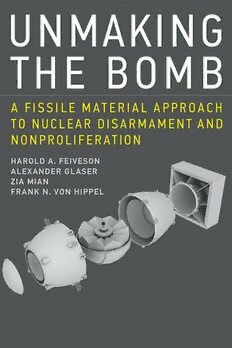
Unmaking the bomb : a fissile material approach to nuclear disarmament and nonproliferation PDF
Preview Unmaking the bomb : a fissile material approach to nuclear disarmament and nonproliferation
Unmaking the Bomb Unmaking the Bomb A Fissile Material Approach to Nuclear Disarmament and Nonproliferation Harold A. Feiveson, Alexander Glaser, Zia Mian, and Frank N. von Hippel The MIT Press Cambridge, Massachusetts London, England © 2014 Massachusetts Institute of Technology All rights reserved. No part of this book may be reproduced in any form by any electronic or mechanical means (including photocopying, recording, or information storage and retrieval) without permission in writing from the publisher. MIT Press books may be purchased at special quantity discounts for business or sales promotional use. For information, please email [email protected]. This book was set in Sabon LT Std 10/13pt by Toppan Best-set Premedia Limited, Hong Kong. Printed and bound in the United States of America. Library of Congress Cataloging-in-Publication Data. Feiveson, Harold A. Unmaking the bomb : a fissile material approach to nuclear disarmament and nonprolifera- tion / Harold Feiveson, Alexander Glaser, Zia Mian, and Frank N. von Hippel. pages cm Includes bibliographical references and index. ISBN 978-0-262-02774-8 (hardcover: alk. paper), 1. Nuclear nonproliferation. 2. Nuclear disarmament. 3. Nuclear fuels— Management. 4. Nuclear fuels— Security measures. I. Glaser, Alexander, 1969– II. Mian, Zia. III. Von Hippel, Frank. IV. Title. JZ5675.F45 2014 327.1 ' 747— dc23 2014003654 10 9 8 7 6 5 4 3 2 1 Si vis pacem para pacem— if you want peace prepare for peace. — Joseph Rotblat (1908– 2005), Manhattan Project physicist and 1995 Nobel Peace Prize Laureate for his “ efforts to diminish the part played by nuclear arms in international politics and, in the longer run, to eliminate such arms ” The day that the last nuclear weapon on earth was destroyed would be a great day. It would be a day for celebrations. We would have given substance to our choice to create the human future. — Jonathan Schell (1943– 2014), author Contents Preface ix Map of Enrichment and Reprocessing Facilities Worldwide xii 1 Introduction 1 I How the Nuclear World Emerged 19 2 Production, Uses, and Stocks of Fissile Materials 21 3 The History of Fissile Material Production for Weapons 43 4 The Global Stockpile of Fissile Material 69 II Breaking the Nuclear Energy-Weapons Link 85 5 Fissile Materials, Nuclear Power, and Nuclear Proliferation 87 6 Ending the Separation of Plutonium 107 7 Ending the Use of HEU as a Reactor Fuel 125 III Eliminating Fissile Materials 141 8 Ending Production of Fissile Materials for Weapons 143 9 Disposal of Fissile Materials 159 10 Conclusion: Unmaking the Bomb 173 Appendix 1: Enrichment Plants 185 Appendix 2: Reprocessing Plants 187 Notes 189 Glossary 233 Bibliography 243 Index 263 Preface This book builds on many years of research, writing, teaching, and policy activism that have aimed to highlight and confront the challenges to our civilization posed by the existence, continued production, and use of fissile materials— primarily, plutonium and highly enriched uranium — the essential ingredients of nuclear weapons. Fissile materials did not exist before 1940, even in the laboratory. The creation of the current global stockpiles of these materials over the past seven decades was a result of decisions by a small number of states to rely on nuclear weapons and on specific technology choices made for nuclear power. As of 2013, there was enough fissile material for a total of over 100,000 nuclear weapons. Almost all of this material was held by the nine states with nuclear weapons, with a very small fraction held under international monitoring by a few non-weapon states. Many people and many policy makers have come to assume that the world can continue indefinitely with thousands of nuclear weap - ons and huge quantities of weapon-usable materials being produced, stored, and used at many locations around the world without disaster occurring. It defies the odds, however, to believe that, because nuclear weapons were not used during the Cold War and because there have been no terrorist nuclear explosions, nothing terrible will ever happen. The book describes the history, production, current stockpiles, and use of fissile materials in nuclear weapons and in nuclear reactor fuel and proposes a set of policies to drastically reduce the quantities and the number of locations around the world where these materials can be found with a view to their total elimination. We hope that it will serve to make more credible to governments and to citizens the need for and opportunities that exist for progress on this policy agenda.
